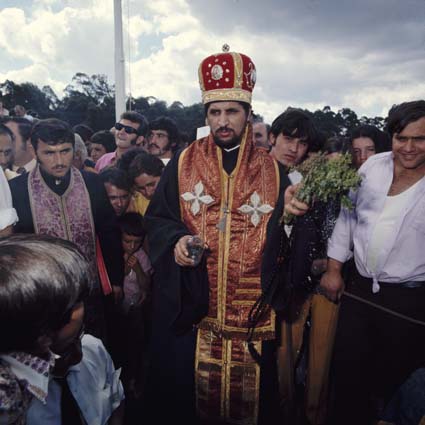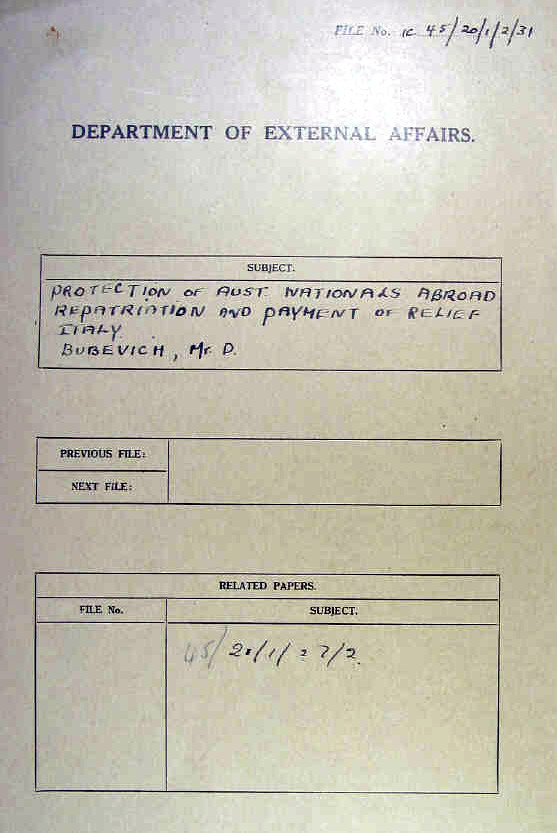Yugoslav spying in Australia
ENTER THE DRAGANS & THE RED PRIEST !
by Sasha Uzunov
It could easily be a plot for a Bruce Lee martial arts film or a Quentin Tarantino blockbuster but fact is stranger than fiction. Here in Australia during the early 1970s, clergy, petty thieves, ex-communicated communists, embezzlers, gamblers, bar room brawlers, and international con men were used by the Yugoslav communist secret police, the dreaded UDBa, to spy and intimidate dissident Croats and Macedonians.
According to a de-classified intelligence report compiled by Australia's domestic spies (ASIO), one method of "recruitment" involved the use of a pro-Yugoslav communist Macedonian Orthodox Christian priest, later de-frocked, who in 1976 offered to act as a character witness in a Melbourne court for a known street brawler of Macedonian background, Dragan "Dragi" Gastevski (aka GASHTEVSKI)--who was facing a criminal charge--in return for spying upon Macedonians and Croats.
ASIO was monitoring the Red Priest because of his pro-Yugoslav communist activities and opened a file on him.
In this ASIO document on Yugoslav diplomat George Trajkovski in 1976 the Red Priest and Gastevski are mentioned at the bottom of the page.
The ASIO report also details Yugoslav government intimidation of the Sveti Georgi (Saint George) Macedonian Orthodox Church in Fitzroy, Melbourne.
ENTER THE DRAGAN 1 - Street brawler Dragan "Dragi" Gastevski (1946-2012), born in the village of Capari, near the town of Bitola in modern day The Republic of Macedonia, which declared its independence from communist Yugoslavia in 1991. Gastevski was facing a criminal assault charge in 1976 for beating up a pro-Yugoslav Macedonian community leader at Preston Town Hall in Melbourne's north. The Red Priest offered to act as a character witness.
Serving two masters? Caesar and God?
The Red Priest, pictured here conducting a Macedonian Orthodox Christian Baptism circa 1970s.
After the fall of Yugoslav communism in 1991, the Red Priest was de-frocked for selling unauthorised souvenirs, such as crucifixes, without church permission.
Melbourne Macedonian community sources have told TEAM UZUNOV that Gastevski tried to throw his weight around in Sydney's Macedonian community but was run out of town and unofficially banned from ever stepping foot in the harbour city.
Gastevski was active in the Sveti Nikola (Saint Nicholas) Macedonian Orthodox Church in Preston and a close associate of pro-Yugoslav communist Georgi "George" Pisevski, a one time President of Sveti Nikola Church.
Georgi "George" Pisevski (1922-2012) was a Macedonian Partizan resistance fighter during World War II and a high ranking Yugoslav communist party member who after the war became a manager of a state owned company called ZIK Tetovo in the western Macedonian town of Tetovo, then under Yugoslav communist control. Pisevski served in the Macedonian Socialist Republican Parliament during the Yugoslav era.
He fled Yugoslavia in the mid 1960s and arrived in Melbourne, Australia, after embezzling funds from the state owned company. In order to be able to return to his homeland of Macedonia, he began working closely with Yugoslav diplomats in Melbourne.
Pisevski was named in an ASIO file belonging to Yugoslav Consul General Georgi Trajkovski (1975-79) who bragged about infiltrating and silencing anti-Yugoslav activities in Melbourne.Trajkovski's ASIO file mentioning Pisevski.
An American expert on UDBa, Dr John Schindler, has uncovered in his research the links between the former Yugoslav communist intelligence service and criminals, who were used to carry out assassinations or attacks on emigre Croats in particular living in the West during the 1970s. Serbian militia leader during the Yugoslav Wars of the 1990s, Zeljko Raznjatovic-Arkan, began as an armed bank robber in Holland and Belgium and also did work for UDBa during the 1970s.
ENTER THE DRAGAN 2 - WHO WAS THE REAL DRAGAN BUBEVICH / BUBEV ?
Dragan Bubevich aka Bubev or Bubevski (1925-2011) was involved in the Sveti Georgi (Saint George) Macedonian Orthodox Church in Fitzroy, Melbourne during the 1960s through to the 1980s and was present during the struggles by the church to resist being taken by the Yugoslav communist government in 1976 (see above ASIO file on the Red Priest and Gastevski).
Bubevich created this image of a Macedonian political dissident who escaped from Yugoslavia after being imprisoned by the Yugoslav communist authorities during the 1940s and 50s and had allegedly shared a prison cell with popular Macedonian non-communist leader and Partizan resistance fighter during World War II, Metodija Andonov-Cento, imprisoned on false charges during a communist show trial in 1946 at the behest of Yugoslav leader Marshal Josip Broz Tito.
There are conflicting reports over where and when Bubevich was born. His tombstone at Fawkner Cemetery in Melbourne's north lists the village of Gjavato, near the town of Bitola, in the present day The Republic of Macedonia and the date as 25 January 1925. The mystery does not end there. The official Fawkner Cemetery records lists Bubevich as Bubevich and not Bubev as his tombstone.
Tombstone written in Macedonian (Latin script)
Here rests Dragan Bubev.
Born 25-1-1925
in the Village of Gjavato, Bitola.
Died 17-3-2011
A relative of the Bubevich family has told TEAM UZUNOV that Bubevich was indeed in prison but for extortion. He had kidnapped the young son of a fellow Macedonian villager who was working in the United States and demanded a ransom. Bubevich was imprisoned. One version has it that once his sentence was served he fled across the border into Greece and eventually made his way to Australia by boat.
However, an Australian External Affairs (later renamed the Department of Foreign Affairs and Trade) document dating from 1945 had Bubevich claiming he was born in Perth, Western Australia on 25 March 1925 and applied to be repatriated to Australia.
Bubevich made the extraordinary and highly contradictory claim hat he had fought with the legendary Macedonian Partizan hero Stif Naumov (Naumof) during World War II. He then escaped to the mountains until the end of the war before crossing over into Greece and fighting against ELAS, the Greek Communist resistance, even though ELAS had fought the Axis and was a de-facto ally of the Macedonian and Yugoslav Partizans. Bubevich further claims he joined the British in Solun (Salonika) and eventually arrived in a refugee camp in Italy.
This probably was an attempt to curry favour with the British. The document does not indicate whether Bubevich was "repatriated" to Australia. TEAM UZUNOV will apply for Bubevich's immigration records through the National Archives of Australia to unravel this mystery.
A Stojan Bubevic, the father of Dragan, is mentioned in Australian naturalisation papers. He lists his place of birth as Giavato, Bitolj, which prior to World War II was under the Serbian monarchy of Yugoslavia but refers to Gjavato, Bitola.
VIETNAM DRAFT DODGER FOR HIREA relative of the Bubevich family has told TEAM UZUNOV that Dragan Bubevich in 1967 at the height of the Vietnam War offered to "fix for a friend from his village with the Australian government not to conscript his 20 year old son, newly arrived in Australia, for military service in Vietnam." It is alleged Bubevich demanded and was paid $500, a huge sum back in the mid 1960s for migrant workers.
However, the scam was exposed when the Commonwealth Police (forerunner of the Australian Federal Police) came knocking on the young man's door for ignoring his national service call up.
It has been further alleged that Bubevich had dealings with ethnic related organised crime groups in Melbourne and worked as an informer for Yugoslav intelligence, UDBa.
He at one time was a part-owner of an inner city pub in Melbourne during the 1980s.
(end)
UPDATE: Friday 27 September 2013
BITOLA - World War II - 70 Year mystery? Did Dragan Bubevich betray or help Macedonian Partizan hero Stevan 'Stif' Naumov in 1942? Or was Bubevich a clever conman who told an elaborate story?
Going through an old story of mine on Dragan Bubevich, a controversial figure in Australia's Macedonian community I made the realisation that there is loose circumstantial evidence at best to link Bubevich to Naumov. It would be great if we could access the Macedonian intelligence files on Naumov and Bubevich to see if my hunch or theory holds any water.
I came across an old Australian Immigration file in the National Archives of Australia - www.naa.gov.au - in which Bubevich gave a statement in 1945, whilst in an Italian refugee camp. How he ended up there no one knows or why?
Bubevich made the extraordinary and highly contradictory claim hat he had fought with the legendary Macedonian Partizan hero Stif Naumov (Naumof) during World War II. He then escaped to the mountains until the end of the war before crossing over into Greece and fighting against ELAS, the Greek Communist resistance, even though ELAS had fought the Axis and was a de-facto ally of the Macedonian and Yugoslav Partizans. Bubevich further claims he joined the British in Solun (Salonika) and eventually arrived in a refugee camp in Italy.
According to Bubevich's claims:
In November 1941 together with Naumov formed a partizan resistence movement.
In April 1942 Bubevich claimed he was arrested by the Bulgarian (occupying) police and imprisoned for three months in Bitola because of his involvement with Naumov, who then organised his escape from jail three months later.
What we do know is Naumov did in fact organise a Partizan detachment, Pelister, in April 1942, in the Bitola/Prespa region.
On 12 September 1942, in the village of Bolno, in the Resen/Prespa region and about 20km east from Bitola Stif Naumov was discovered in a private house by Bulgarian police. He and his comrades committed suicide to avoid certain capture and brutal torture at the hands of the Bulgarian police.
Did Bubevich tip off the Bulgarian police?
Bubevich, was from the village of Gjavato, close to Bitola and about 10km from Bolno across the mountains or 20km by road. Bubevich's first wife was from Slivnica in the Resen/Prespa region. So the area would have been familiar to him.
For a man with limited education and poor village background, Bubevich's story in 1945 contains some interesting facts about Naumov in April 1942.
Later when Bubevich migrated to Australia he would make the extraordinary claim that he did jail time in communist Yugoslavia as a political prisoner and had shared a cell with Macedonia's greatest heros, Metodija Andonov Cento, partizan resistence leader locked up on false charges in 1946.
Moreover, Victoria Police knew of Bubevich's links to organised crime in Melbourne, especially in the Dandenong area....Photo of Stevan "Stif" Naumov - link to wikipedia




















